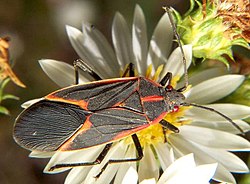Boxelder bug
| Boisea trivittata | |
|---|---|

| |
| Scientific classification | |
| Kingdom: | |
| Phylum: | |
| Class: | |
| Order: | |
| Suborder: | |
| Superfamily: | |
| Family: | |
| Subfamily: | Stål, 1862
|
| Genus: | |
| Species: | B. trivittata
|
| Binomial name | |
| Boisea trivittata (Say, 1825)
| |
| Synonyms | |
|
Leptocoris trivittatus | |
The boxelder bug (Boisea trivittata) is a North American species of true bug. It is found primarily on boxelder trees, as well as maple and ash trees.[1] The adults are about 12.5 millimetres (0.49 in) long with a dark brown or black coloration, relieved by red wing veins and markings on the abdomen; nymphs are bright red.[2]
Etymology
Trivittata is from the Latin tri (three) + vittata (banded).[3]
Biology and taxonomy
These highly specialized insects feed almost exclusively on the seeds of Acer species. The boxelder bug is sometimes confused with Jadera spp., or its western counterpart, Boisea rubrolineata. The name "stink bug," which is more regularly applied to the family Pentatomidae, is sometimes erroneously used to refer to Boisea trivittata. Instead, these insects belong to the family Rhopalidae, the so-called "scentless plant bugs". However, boxelder bugs are redolent and will release a pungent and bad-tasting compound upon being disturbed to discourage predation. This allows them to form conspicuous aggregations without being preyed on.[4]
As pests
Although they specialize on Acer seeds, they may pierce plant tissues while feeding. They are not known to cause significant damage and are not considered to be agricultural pests.[citation needed] However, their congregation habits and excreta can annoy people; for this reason, they are considered nuisance pests. Removal of boxelder and other Acer species can help in control of bug populations.
They may form large aggregations while sunning themselves in areas near their host plant (e.g. on rocks, shrubs, trees, and man-made structures). This is especially a problem during the cooler months, when they sometimes invade houses and other man-made structures seeking warmth or a place to overwinter. They remain inactive inside the walls (and behind siding) while the weather is cool. When the heating systems revive them, some may falsely perceive it to be springtime and enter inhabited parts of the building in search of food, water, and conspecifics. In the spring, the bugs leave their winter hibernation locations to feed and lay eggs on maple or ash trees; aggregations may be seen during this time and well into summer and early fall, depending on the temperature.
-
Mating Small Milkweed Bugs (Lygaeus kalmii) in Lockport, New York. Sometimes confused with Boxelders.
References
- ^ Boxelder Bugs University of Minnesota
- ^ Göllner-Scheiding, U. (1983): General-Katalog der Familie Rhopalidae (Heteroptera). Mitt. Zool. Mus. Berlin 59, 37-189.
- ^ "vittatus".
- ^ Aldrich, J.R., Carroll, S.P., Oliver, J.E., et al. (1990) Exocrine secretions of scentless plant bugs: Jadera, Boisea and Niesthrea species. Biochemical Systematics and Ecology, 18, 369-376.
External links
 Media related to Boisea trivittata at Wikimedia Commons
Media related to Boisea trivittata at Wikimedia Commons- Box Elder Bug - large format photos and information




